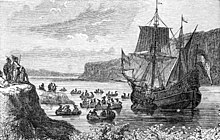New City is a hamlet and census-designated place in the town of Clarkstown, Rockland County, New York, United States, part of the New York Metropolitan Area. The hamlet is a suburb of New York City and is located 18 miles (29 km) north of the city at its closest point, Riverdale, The Bronx. New City has grown to be a wealthy, affluent suburb of New York City. Within Rockland County, New City is located north of Bardonia, northeast ofNanuet, east of New Hempstead, south of Garnerville, and west, straight across Lake Deforest, of Congers. New City's population was 33,559 at the 2010 census,[1] making it the 14th most populous CDP/hamlet in the state of New York.[2]
New City is the county seat of Rockland County[3] and the location of the Clarkstown Police Department, Sheriff's office and corrections facility. The ZIP code of New City is 10956.
New City Homes for Sale
New City Real Estate
History

The area that would become Rockland County was originally inhabited by Algonquian-speaking Indians, including Munsees, or Lenni Lenape.
In 1609, Henry Hudson, thinking he had found the legendary "Northwest Passage", sailed on the Half Moon up the river that would one day bear his name and anchored near the area that is now Haverstraw before continuing to disillusionment north of Albany. The Dutch were the first Europeans to settle in the area, around 1675.[2] These settlers, eager to escape "city life", moved from Manhattan to Rockland. A number of unique Dutch-style red sandstone houses still stand, and many place names in the county reveal their Dutch origin. When the Duke of York (who became King James II of England) established the first twelve counties of New York in 1683, present-day Rockland County was part of Orange County. Orangetown was created at the same time under a royal grant, originally encompassing all of modern Rockland County. Around this time, as the English began to colonize Nyack and Tappan, the Native Americans began to leave Rockland in search of undisturbed land further north.[2] Haverstraw was separated from Orangetown in 1719 and became a town in 1788; it included the present-day Clarkstown, Ramapo and Stony Point. Clarkstown and Ramapo became towns in 1791, followed by Stony Point in 1865. Rockland County was split from Orange County in 1798. The natural barrier of the Ramapo Mountains and the size of the county made it difficult to carry out governmental activities. At one point there were twin governments, one on each side of the Ramapo Mountains. For this reason, Rockland split off from Orange in 1798 to form its own county. That same year the county seat was transferred from Tappan to New City, where a new courthouse was built.

During the American Revolution, when control of the Hudson River was viewed by the British as strategic to dominating the American territories, Rockland sawskirmishes at Haverstraw, Nyack and Piermont, and significant military engagements at the Battle of Stony Point, where General "Mad" Anthony Wayne earned his nickname. George Washington had headquarters for a time at John Suffern's tavern, the later site of the village of Suffern. British Major John André met with American traitor Benedict Arnold near Stony Point to buy the plans for the fortifications at West Point. André was captured with the plans in Tarrytown on his way back to the British lines; he was brought to Tappan for trial in the Tappan church, found guilty, hanged and buried nearby. Still another important chapter in the story of the Revolution was written on May 5, 1783, when General Washington received Sir Guy Carleton at the DeWint House, where they discussed the terms of the peace treaty. Two days later Washington visited Sir Guy aboard a British war vessel. On this day the King's Navy fired its first salute to the flag of the United States of America.
In the decades following the Revolution, Rockland became popular for its stone and bricks. These products, however, required quarrying in land that many later believed should be set aside as a preserve. Many unsuccessful efforts were made to turn much of the Hudson Highlands on the northern tip of the county into a forest preserve. However, Union Pacific Railroad president E. H. Harriman donated land as well as large sums of money for the purchase of properties in the area of Bear Mountain. Bear Mountain/Harriman State Park became a reality in 1910, and by 1914 it was estimated that more than a million people a year were coming to the park.
Rockland remained semi-rural until the 1950s when the Palisades Interstate Parkway, Tappan Zee Bridge, and other major arteries were built. The idea ofsuburbia also helped transform the county. The county's population flourished, from 89,276 in 1950 to 265,475 in 1990.

Comments (0)Subscribe to CommentsComment